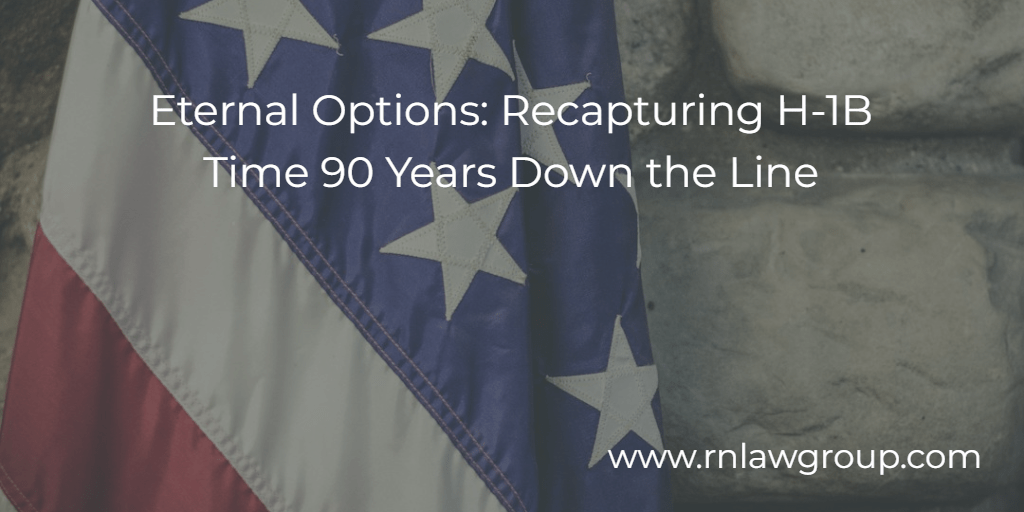
Eternal Options: Recapturing H-1B Time 90 Years Down the Line
In the labyrinth of U.S. immigration policy, H-1B holders with approved I-140 petitions find themselves ensnared in a frustrating limbo. Despite their contributions to American society and the workforce, they’re confronted with a seemingly interminable wait for green card availability. It’s a waiting game that tests patience, endurance, and often, the boundaries of hope. However, amidst this exasperating predicament, a seemingly simplistic yet profoundly overlooked solution emerges: leaving the United States. Departing may sound counterintuitive, but the prospect of recapturing H-1B time offers a glimmer of hope, stretching beyond the foreseeable future, even 90 years down the line.
H-1B Visa Essentials: Cap, Time Limits, and Extensions
The H-1B visa program in the United States imposes both a numerical cap and a time limit on its beneficiaries. The annual cap restricts the number of new H-1B visas granted each fiscal year, typically set at 85,000, with 20,000 reserved for individuals with advanced degrees. Once an individual secures an H-1B visa, they are typically allowed to remain in the U.S. for a maximum of six years, granted in increments of up to three years initially, with potential extensions. This six-year limit is in place to ensure that H-1B visa holders do not remain indefinitely in the U.S. without transitioning to a more permanent immigration status. Upon reaching the end of this period, individuals are generally required to either leave the country or seek alternative pathways for immigration status, such as employer-sponsored green cards or other work visas.
For individuals hailing from countries facing extensive backlogs in the employment-based green card system, the standard six-year duration of H-1B status often proves insufficient for a seamless transition. The cap on employment-based green cards, coupled with per-country limits, creates significant delays in the processing of applications, prolonging the wait for permanent residency. As a result, even with an approved I-140 petition in hand, individuals from backlog-heavy nations may find themselves constrained by the time constraints of their H-1B visa, unable to secure a green card before reaching the six-year threshold. Is departing from the United States a viable option given the distant prospects of immigration reform?
Coming Back Strong: Reentering the U.S. After Time on H-1B and an Approved I-140
According to 8 CFR 214.2(h)(8)(ii)(A), every individual who has received an H-1B visa or has been granted H-1B nonimmigrant status is accounted for within the numerical cap, unless their petition was submitted by an institution that is exempt from the cap. Notably, individuals who previously held H-1B status and possess an approved I-140 petition can leave the United States and still have the option to return and regain H-1B status in the future without needing to go through the lottery process again. This provision serves as a crucial pathway for skilled workers to navigate the intricacies of the U.S. immigration system, particularly amidst the prolonged wait for green card availability.
Maximizing Previous H-1B Cap Approvals for Future Applications
To return to the United States, any employer may initiate a new H-1B petition on the individual’s behalf, accompanied by a request for consular processing. Crucially, the employer must designate the petition as “cap exempt” on the H-1B Data Collection and Filing Fee Exemption Supplement form, indicating that the beneficiary has already been counted against the cap and is seeking the remaining portion of the 6-year admission period. The petition should include copies of all prior H-1B petition approvals. The I-140 approval must also be included. This documentation is imperative to affirm the beneficiary’s eligibility for the cap exemption and stats beyond the normal six-year limit. Upon approval, the Beneficiary would then apply for the visa to be stamped in his or her passport at a U.S. embassy or consulate abroad and then travel back to the United States to begin work.
Clearing Up Misconceptions About Deadlines
A crucial aspect of submitting a cap-exempt H-1B petition lies in its flexible timing. Unlike many other visa procedures, there exists no rigid deadline for filing such a petition. Applicants aren’t obligated to submit it within the validity period of their prior approval, distinguishing it from an H-1B transfer, which typically mandates adherence to specific validity dates. Moreover, the submission of this cap-exempt petition isn’t confined by the standard 6-year limit on H-1B status. This implies that individuals can file for a cap-exempt H-1B petition even after several years have passed since their initial approval. Such flexibility presents a significant advantage for beneficiaries previously counted under the H-1B cap, enabling them to apply for a new H-1B visa without the time-related pressures commonly associated with other visa categories.
It’s important to note that while there is flexibility in timing when filing a cap-exempt H-1B petition to return to the U.S., there’s a critical deadline to consider: ensuring that the priority date on the approved I-140 petition is not current. Once the priority date becomes current, it signifies that a visa number is available, potentially rendering the individual ineligible for continued H-1B status beyond the six-year limit. Therefore, applicants should vigilantly monitor the Visa Bulletin to stay informed about priority date movements and act swiftly to file their H-1B petition before their priority date becomes current. Failure to adhere to this deadline could result in losing the opportunity for cap-exempt status and may necessitate reevaluating alternative immigration pathways.
Choices Without an Approved I-140
For individuals who haven’t exhausted their full six-year allocation on H-1B status, a similar option exists based on provisions permitting the recapture of time spent outside the United States. However, it’s crucial to recognize that they will only be eligible for the remainder of their allotted time upon reentry. Therefore, it’s imperative to strategize carefully to ensure that there’s adequate time to obtain an approved I-140 petition before the expiration of the remaining H-1B time requested.
Conclusion
In navigating the convoluted landscape of U.S. immigration, the plight of H-1B holders with approved I-140 petitions from backlogged countries stands as a testament to the complexities and frustrations inherent in the system. While the pathway to permanent residency remains obscured by lengthy backlogs and uncertain timelines, a glimmer of hope emerges for those considering departure from the United States. Despite the challenges, the prospect of recapturing H-1B time offers a unique opportunity for individuals to transcend the limitations of the present and secure a future in the country, even ninety years down the line. However, the journey back to the U.S. hinges on strategic planning. While the H-1B program offers flexibility in timing, it’s imperative to note the importance of monitoring the priority date on the approved I-140 petition. Failing to act before this date becomes current could jeopardize one’s eligibility for continued H-1B status. Therefore, vigilance and proactive measures are paramount in navigating the intricacies of immigration law and securing a successful return to the United States.
By: Emily Neumann
Emily Neumann is Managing Partner at Reddy Neumann Brown PC with over 15 years of experience practicing US immigration law providing services to U.S. businesses and multinational corporations. Emily has helped transform the firm from a solo practice to Houston’s largest immigration law firm focused exclusively on U.S. employment-based immigration. She received her Bachelor’s degree in Biology from Central Michigan University and her Juris Doctorate degree from the University of Houston Law Center. Emily is a frequent speaker and has been quoted in Bloomberg Law, U.S. News & World Report, Inside Higher Ed, and The Times of India on various hot topics in immigration. She is a member of the American Immigration Lawyers Association and Society for Human Resource Management.
Reddy & Neumann has been serving the business community for over 25 years and is Houston’s largest immigration law firm focused solely on US. Employment-based immigration. We work with both employers and their employees, helping them navigate the immigration process quickly and cost-effectively.

